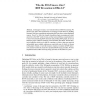CACM
2008
14 years 12 days ago
2008
The goal of semantic web research is to allow the vast range of web-accessible information and services to be more effectively exploited by both humans and automated tools. To fac...
BMCBI
2010
14 years 12 days ago
2010
Background: Biomedical research is set to greatly benefit from the use of semantic web technologies in the design of computational infrastructure. However, beyond well defined res...
AO
2007
14 years 13 days ago
2007
This work introduces a formal framework for the social acquisition of ontologies which are constructed dynamically from overhearing the possibly conflicting symbolic interaction o...
GI
2008
Springer
14 years 1 months ago
2008
Springer
In order to be adopted within corporate environments, Semantic Web applications must provide tangible short-/medium-term gains. Although corporate Semantic Web offers enterprises n...
HPDC
2010
IEEE
14 years 1 months ago
2010
IEEE
The Semantic Web consists of many billions of statements made of terms that are either URIs or literals. Since these terms usually consist of long sequences of characters, an effe...
SWWS
2007
14 years 1 months ago
2007
−The ability for software agents to discover, query, and task ubiquitous sensors requires machineinterpretable service descriptions, such as those proposed by the Semantic Web ef...
SWAP
2007
14 years 1 months ago
2007
In this paper we take a view from the bottom to RDF(S) reasoning. We discuss some issues and requirements on reasoning towards effectively building Semantic Web Pipes, aggregating ...
SWAP
2007
14 years 1 months ago
2007
An issue that is equally arising both from social networks and the Semantic Web is the fact that, without the consistent use of the same identifier for an object across systems, i...
PSSS
2003
14 years 1 months ago
2003
The semantic web is a promising application-area for the Prolog programming language for its non-determinism and patternmatching. In this paper we outline an infrastructure for loa...
PSSS
2003
14 years 1 months ago
2003
: RDF-based tools promise to provide a base for reasoning about metadata and about situated data—data describing entities situated in time and space—that is superior to alterna...

